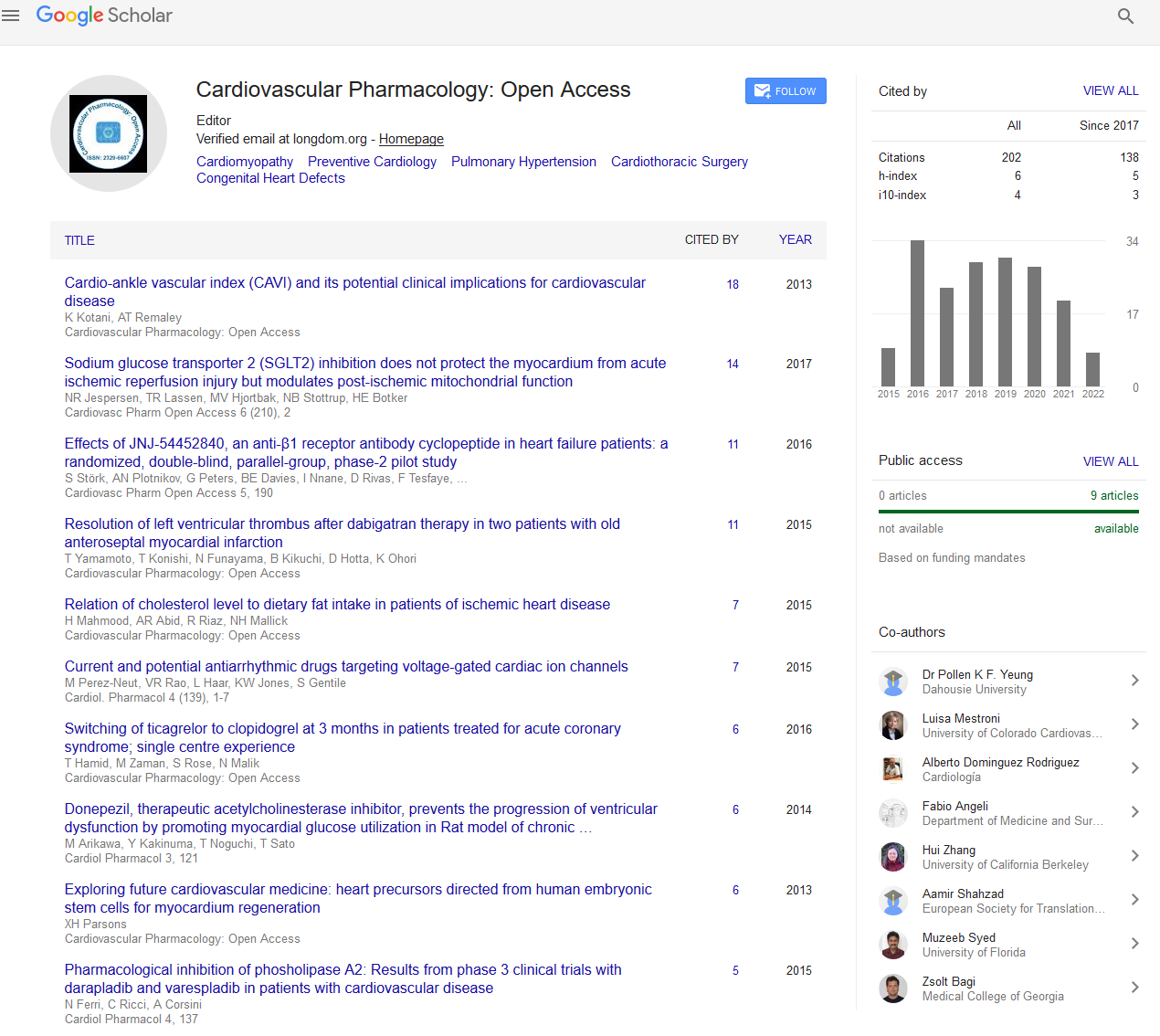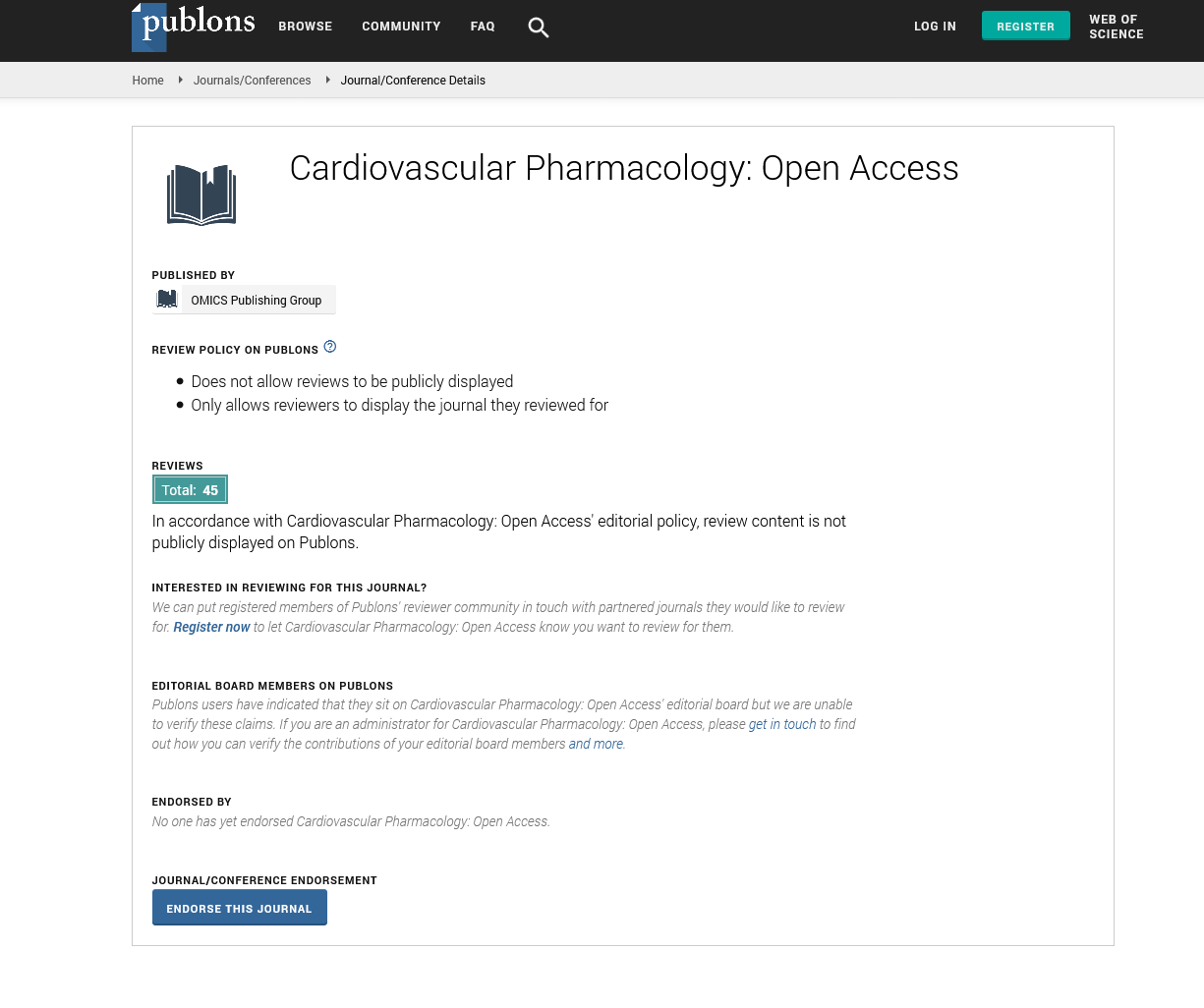Indexed In
- Open J Gate
- Cosmos IF
- RefSeek
- Hamdard University
- EBSCO A-Z
- OCLC- WorldCat
- Publons
- Geneva Foundation for Medical Education and Research
- Euro Pub
- Google Scholar
Useful Links
Share This Page
Journal Flyer

Open Access Journals
- Agri and Aquaculture
- Biochemistry
- Bioinformatics & Systems Biology
- Business & Management
- Chemistry
- Clinical Sciences
- Engineering
- Food & Nutrition
- General Science
- Genetics & Molecular Biology
- Immunology & Microbiology
- Medical Sciences
- Neuroscience & Psychology
- Nursing & Health Care
- Pharmaceutical Sciences
Commentary - (2025) Volume 14, Issue 2
Novel Approaches in Antihypertensive Pharmacotherapy
Marta Kowalska*Received: 29-May-2025, Manuscript No. CPO-25-29831; Editor assigned: 31-May-2025, Pre QC No. CPO-25-29831; Reviewed: 14-Jun-2025, QC No. CPO-25-29831; Revised: 20-Jun-2025, Manuscript No. CPO-25-29831; Published: 28-Jun-2025
Description
Hypertension is one of the most prevalent chronic conditions worldwide and a major contributor to cardiovascular morbidity and mortality. Effective pharmacological management is essential to reduce the risk of stroke heart failure and renal disease. Over the year’s multiple drug classes have been developed each targeting different mechanisms involved in blood pressure regulation. Diuretics were among the earliest drugs introduced for hypertension management. They reduce intravascular volume and thereby decrease blood pressure. Thiazide diuretics remain widely used due to their affordability and proven efficacy in lowering cardiovascular events. However, their metabolic side effects such as hypokalemia and glucose intolerance limit their use in certain populations including those with diabetes or metabolic syndrome.
Angiotensin-Converting Enzyme (ACE) inhibitors and Angiotensin Receptor Blockers (ARBs) target the reninangiotensin system which plays a central role in blood pressure regulation. By blocking the formation or action of angiotensin II they induce vasodilation and reduce aldosterone-mediated sodium retention. These agents are particularly beneficial in patients with diabetes or chronic kidney disease due to their protective effects on renal function and their ability to reduce proteinuria. ACE inhibitors also confer additional cardiovascular benefits by reducing cardiac remodeling following myocardial infarction. Calcium Channel Blockers (CCBs) provide another effective mechanism by inhibiting calcium influx into vascular smooth muscle cells resulting in vasodilation. They are especially useful in elderly patients with isolated systolic hypertension and have demonstrated efficacy in preventing stroke and other cardiovascular complications. Dihydropyridine CCBs like amlodipine are commonly prescribed for this purpose. Nondihydropyridine CCBs such as verapamil and diltiazem also reduce heart rate and have a role in managing certain arrhythmias.
Beta blockers reduce heart rate and myocardial contractility thereby lowering cardiac output and blood pressure. They are preferred in patients with concurrent ischemic heart disease or arrhythmias because of their ability to reduce myocardial oxygen demand and prevent arrhythmic events. However, they may be less effective than other agents in stroke prevention when used as monotherapy and their use may be limited by side effects such as fatigue and sexual dysfunction. In recent years, novel drug classes have been introduced to expand treatment options. Direct renin inhibitors such as aliskiren act earlier in the reninangiotensin cascade offering another avenue for blood pressure reduction. However, their use remains limited due to concerns about adverse effects when combined with other reninangiotensin system blockers, especially in patients with diabetes or renal impairment. Sodium-Glucose Cotransporter 2 (SGLT2) inhibitors originally developed for diabetes management have demonstrated blood pressure-lowering effects likely related to osmotic diuresis and weight loss. This dual benefit makes them attractive in patients with hypertension and type 2 diabetes.
Emerging research is exploring additional pathways involved in blood pressure control. Endothelin receptor antagonists which block potent vasoconstrictors are under investigation for resistant hypertension. Neprilysin inhibitors combined with angiotensin receptor blockers represent another novel approach that enhances natriuretic peptides promoting vasodilation and natriuretic. Such innovations highlight the growing complexity and precision of antihypertensive therapy. The future of hypertension management lies in personalized medicine where genetic profiling and biomarkers could guide drug selection optimizing efficacy and minimizing side effects. For example, certain polymorphisms in genes encoding components of the renin-angiotensin system may predict better response to ACE inhibitors or ARBs. Likewise, pharmacogenomics testing could identify patients at risk of adverse reactions improving safety.
Combination therapy remains the cornerstone of hypertension treatment as most patients require two or more agents to achieve adequate blood pressure control. Fixed-dose combinations which combine two or more drugs in a single pill improve adherence by simplifying treatment regimens and reducing pill burden. This is critical as poor adherence is a major barrier to effective hypertension control and increases the risk of cardiovascular events. Despite the availability of multiple pharmacological options hypertension remains underdiagnosed and undertreated in many regions worldwide. Socioeconomic factors limited healthcare access and low awareness contribute to this treatment gap. Public health initiatives focusing on screening education and affordable medication availability are essential in closing this gap and maximizing the benefits of antihypertensive therapy.
In summary hypertension is a complex multifactorial disease requiring a comprehensive pharmacological approach tailored to individual patient profiles. With continued innovation in drug development personalized treatment strategies and enhanced healthcare delivery systems antihypertensive pharmacotherapy will remain a cornerstone in reducing the global burden of cardiovascular disease and improving patient outcomes.
Citation: Kowalska M (2025) Novel Approaches in Antihypertensive Pharmacotherapy. 14:428
Copyright: © 2025 Kowalska M. This is an open access article distributed under the terms of the Creative Commons Attribution License, which permits unrestricted use, distribution AND reproduction in any medium, provided the original author and source are credited.


